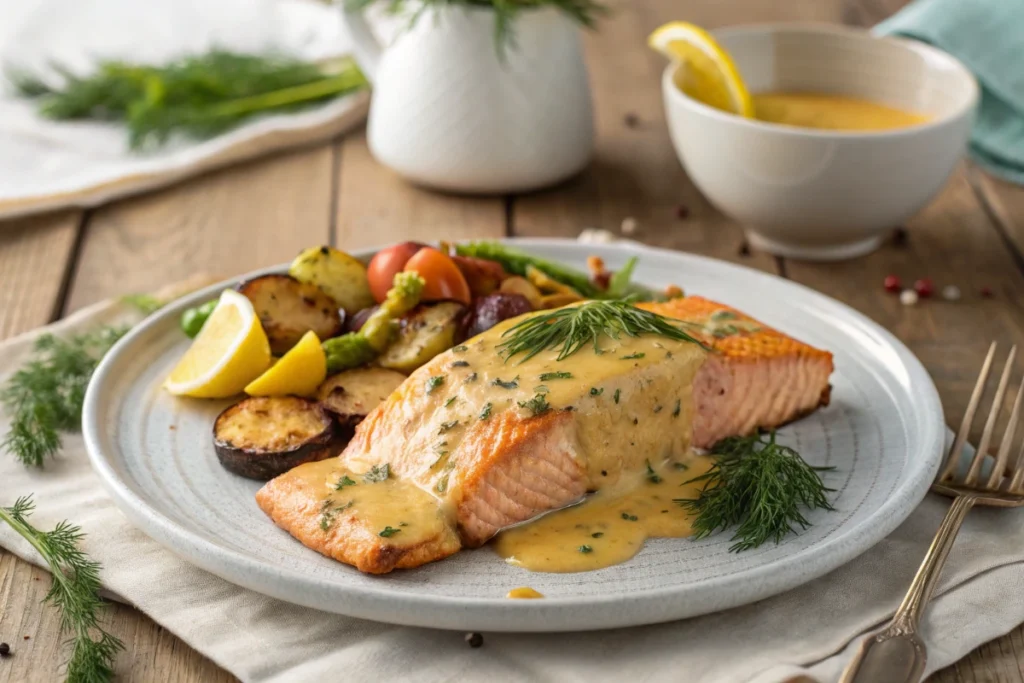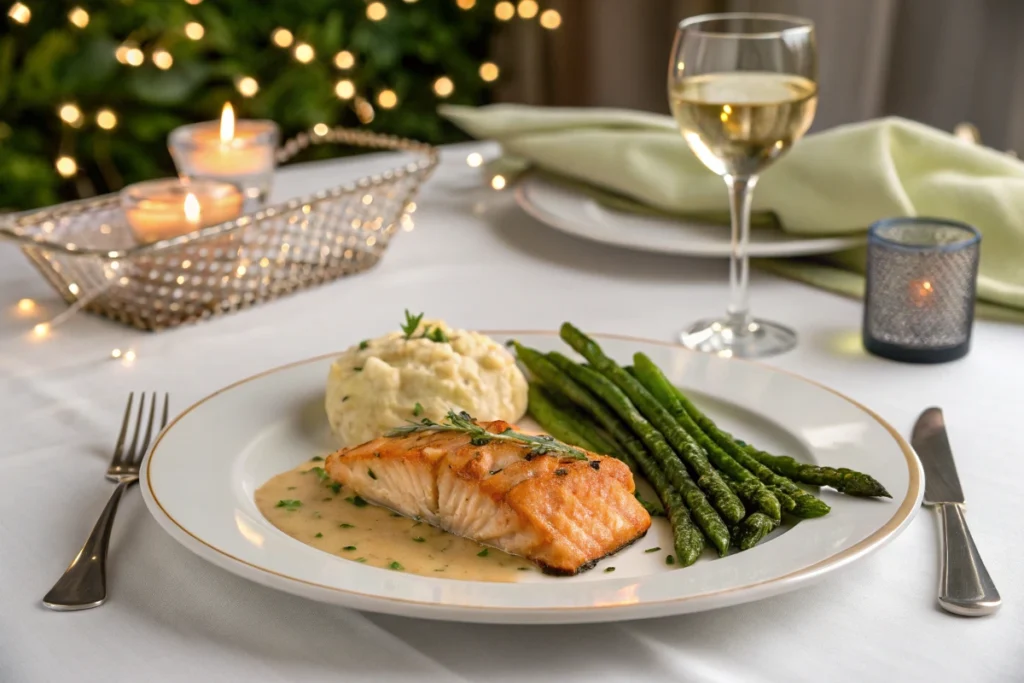
Baked salmon fillets with Dijon mustard are a simple yet elegant dish. Salmon is a highly nutritious and versatile fish. When paired with the tangy flavor of Dijon mustard, it becomes an irresistible meal. This recipe is perfect for a dinner party or a quick weeknight dinner.
Why choose this dish? It’s flavorful, healthy, and incredibly easy to make. Salmon offers a protein-rich option that fits into many diets. Combined with Dijon mustard, it creates a meal that’s both delicious and nutritious.
In this article, we’ll explore why salmon is so good for you and how Dijon mustard enhances its flavor. We’ll also provide a detailed recipe, helpful tips, and pairing ideas. Finally, we’ll answer common questions to help you master this recipe.
Let’s get started on this tasty culinary adventure!
Table of Contents
Benefits of Eating Salmon & Why Use Dijon Mustard for Cooking
Benefits of Eating Salmon
Salmon is one of the healthiest protein sources you can add to your diet. It’s not just delicious but also packed with nutrients that support overall health. Let’s break down the key benefits of eating salmon:
Packed with Omega-3 Fatty Acids
Salmon is rich in omega-3 fatty acids, which are essential for heart and brain health. These healthy fats reduce inflammation, lower blood pressure, and improve cholesterol levels. Studies also suggest that omega-3s boost cognitive function and may even reduce the risk of dementia. Including salmon in your diet is an easy way to give your body these vital nutrients.
High-Quality Protein Source
Protein is the building block of muscles, tissues, and enzymes in the body. Salmon provides a lean, high-quality source of protein that helps repair tissues and maintain muscle mass. For those on a weight loss journey, salmon’s protein content keeps you full longer, reducing cravings.
Loaded with Vitamins and Minerals
Salmon is a powerhouse of essential vitamins like B12, D, and selenium. Vitamin B12 supports energy production and neurological function. Vitamin D, often lacking in many diets, strengthens bones and boosts immunity. Selenium acts as an antioxidant, protecting your cells from damage.
Supports Skin and Hair Health
The healthy fats and vitamins in salmon contribute to radiant skin and shiny hair. Omega-3s lock in moisture, while vitamins boost collagen production, making your skin look youthful.
Why Use Dijon Mustard for Cooking?
Dijon mustard serves not only as a condiment but also as an effective tool for crafting bold and flavorful dishes. Its unique taste and versatility make it a perfect addition to salmon recipes.
A Flavorful Kick
Dijon mustard brings a tangy and slightly spicy flavor that elevates the natural richness of salmon. Its smooth texture ensures even coating, infusing every bite with its signature taste. Whether you prefer a mild or zesty profile, Dijon can be adjusted with other ingredients to suit your palate.
Versatility in Pairings
Dijon mustard pairs well with countless ingredients, from herbs to citrus and honey. It acts as a flavor bridge, bringing out the best in salmon and accompanying sides. Whether you serve it with roasted vegetables, quinoa, or creamy sauces, Dijon mustard ties the meal together.
Health Benefits
Dijon mustard isn’t just tasty; it’s healthy too. Made from mustard seeds, it’s low in calories and rich in antioxidants. It’s a great way to add flavor without relying on sugar-laden sauces.
The Perfect Recipe: Baked Salmon Fillets Dijon
Preparing baked salmon fillets with Dijon mustard is not only easy but also incredibly rewarding. With just a few simple steps and ingredients, you’ll create a dish that tastes like it came straight from a restaurant. Let’s begin with the essentials.
Ingredients You’ll Need
Here’s what you’ll need to craft this flavorful dish:
- Salmon Fillets: 4 skin-on or skinless fillets (about 6 oz each).
- Dijon Mustard: 3 tablespoons for that signature tangy flavor.
- Honey: 1 tablespoon to balance the acidity of the mustard.
- Garlic: 2 cloves, minced, for added depth.
- Olive Oil: 1 tablespoon to ensure the salmon stays moist and flaky.
- Lemon Juice: Juice of 1 lemon to brighten the dish.
- Salt and Pepper: To taste.
- Fresh Herbs (optional): Dill or parsley to garnish.
Optional Ingredients for Variations:
- Breadcrumbs: Add for a crunchy topping.
- Paprika or Cayenne Pepper: For a hint of spice.
- Soy Sauce: For a savory, umami flavor twist.
Step-by-Step Cooking Instructions
1. Prepare the Salmon
To start, preheat your oven to 375°F (190°C). While the oven is heating, rinse the salmon fillets under cold water and pat them dry with paper towels. Next, place the fillets on a lined baking sheet or in a greased baking dish to prevent sticking.
2. Mix the Dijon Sauce
In a small bowl, whisk together Dijon mustard, honey, garlic, olive oil, and lemon juice. Then, add a pinch of salt and pepper to the mixture. Be sure to taste and adjust the seasoning if needed.
3. Coat the Salmon
Now, brush the Dijon mixture generously over each salmon fillet. Make sure you cover the entire surface evenly. If you’re using breadcrumbs or spices, sprinkle them on top at this stage for extra texture and flavor.
4. Bake the Salmon
Place the salmon in the preheated oven and bake for 12-15 minutes. The cooking time will vary depending on the thickness of your fillets. To check for doneness, insert a fork into the thickest part of the fillet. If the salmon flakes easily and has an internal temperature of 145°F (63°C), it’s ready to serve.
5. Garnish and Serve
Finally, remove the salmon from the oven and let it rest for 2-3 minutes. Garnish with fresh herbs and a slice of lemon for added appeal. Serve immediately with your favorite sides, and enjoy!
Common Mistakes to Avoid
When preparing baked salmon fillets Dijon, there are a few pitfalls to watch out for:
- Overcooking the Salmon: Overbaked salmon can turn dry and chewy. To avoid this, use a thermometer to ensure perfect doneness.
- Skipping the Pat-Dry Step: Always pat the salmon dry before adding the sauce. Otherwise, the moisture can prevent the Dijon mixture from sticking.
- Using Low-Quality Salmon: High-quality, fresh salmon makes a noticeable difference in taste and texture. Choose fillets from a trusted source.
Enhancements: Garnishes and Sides
To elevate your meal, pair your baked salmon fillets with Dijon with a variety of sides. For instance, roasted vegetables like asparagus, broccoli, or Brussels sprouts add vibrant color and nutrition. Similarly, grains such as quinoa, rice, or couscous complement the richness of the salmon.
Additionally, a fresh side salad with vinaigrette offers a light and refreshing contrast. If you want to add an extra layer of flavor, drizzle some balsamic glaze or serve with a creamy dill sauce. These additions will elevate your dish to a new level.
Tips for Perfectly Baked Salmon
Whether you’re a seasoned cook or a beginner, these tips will help you nail this dish every time. Whether you’re a seasoned cook or a beginner, these tips will help you nail this dish every time.
Choosing Fresh Salmon
First and foremost, always start with fresh salmon. Look for fillets with bright, firm flesh and no unpleasant odor. Fresh salmon should smell faintly of the ocean, not fishy. If you’re using frozen salmon, thaw it properly by placing it in the refrigerator overnight or running it under cold water for quick thawing.
Temperature and Timing Matter
Precision is key when baking salmon. Preheat your oven to the correct temperature (375°F or 190°C for this recipe). Baking salmon at the right temperature ensures it cooks evenly, retaining its moisture.
For timing, aim for about 12-15 minutes, depending on the fillet’s thickness. If the fillets are particularly thick, you may need an extra minute or two. Use a meat thermometer to check for doneness. The internal temperature should reach 145°F (63°C) at the thickest part.
Don’t Skip the Sauce
Dijon mustard not only adds flavor but also locks in moisture, keeping the salmon tender. Spread the sauce generously and evenly for the best results. For added texture, consider sprinkling breadcrumbs or crushed nuts on top before baking.
Rest Before Serving
After removing the salmon from the oven, let it rest for 2-3 minutes. This allows the juices to redistribute throughout the fillet, ensuring each bite is tender and flavorful.
Pairing Suggestions and Meal Ideas

Pairing your baked salmon fillets Dijon with the right sides and beverages can elevate your dining experience. Here are some tried-and-true combinations to inspire your next meal.
Best Side Dishes
- Roasted Vegetables: Asparagus, green beans, or Brussels sprouts roasted with olive oil and garlic complement the salmon’s richness.
- Grain Bowls: Quinoa, wild rice, or couscous add a hearty element to the meal. Consider tossing them with herbs and a light vinaigrette for extra flavor.
- Mashed Potatoes: Creamy mashed potatoes or a lighter cauliflower mash provide a comforting, creamy contrast.
- Salads: A crisp green salad with arugula, spinach, or kale adds a refreshing crunch. Pair it with a lemon vinaigrette for a citrusy note.
Wines to Complement the Dish
When it comes to beverages, salmon pairs beautifully with white wines and light reds. Here are some suggestions:
- Chardonnay: A creamy, oaky Chardonnay balances the tanginess of Dijon mustard.
- Pinot Grigio: This light and zesty white wine enhances the dish’s citrus notes.
- Pinot Noir: A soft, fruity red wine complements the salmon without overpowering it.
If you prefer non-alcoholic options, sparkling water with a splash of lemon or a citrus iced tea makes a great match.
Creative Meal Ideas

Looking to switch things up? Here are a few ways to use baked salmon fillets Dijon in other meals:
- Salmon Tacos: Flake the salmon and serve it in soft tortillas with slaw and a drizzle of lime crema.
- Salmon Salad: Toss the salmon with mixed greens, avocado, and a Dijon vinaigrette for a quick, healthy lunch.
- Salmon Pasta: Mix the salmon with your favorite pasta, a squeeze of lemon, and a creamy Alfredo or light olive oil sauce.
These options are not only delicious but also a great way to repurpose leftovers.
FAQs About Baked Salmon Fillets Dijon
To ensure success with this dish, here are answers to some of the most common questions. These tips will help you confidently prepare and enjoy baked salmon fillets Dijon.
Can I Use Regular Mustard Instead of Dijon?
Yes, you can substitute Dijon mustard with regular yellow mustard, but the flavor will differ. Dijon mustard has a tangy, sharp taste with a smooth texture that complements salmon perfectly. Yellow mustard is milder and slightly sweeter, so the dish will lack some of Dijon’s signature punch. If you want a closer match, try blending yellow mustard with a touch of white wine or vinegar.
What’s the Best Way to Store Leftovers?
To store leftovers, let the baked salmon cool completely, then transfer it to an airtight container. Refrigerate for up to 3 days. For longer storage, freeze the salmon in a sealed freezer bag or container for up to 2 months. When reheating, avoid drying out the fillets by using a low oven temperature or a microwave with a damp paper towel covering the dish.
How Can I Make This Recipe Gluten-Free?
This recipe is naturally gluten-free if you skip breadcrumbs or use gluten-free alternatives. Be sure to check the labels of all ingredients, especially Dijon mustard and any seasoning blends, to ensure they are certified gluten-free.
Can I Add Other Herbs and Spices?
Absolutely! Fresh herbs like dill, parsley, or cilantro can enhance the flavor of the dish. For a spicier version, add cayenne pepper, smoked paprika, or red pepper flakes to the Dijon sauce. Feel free to experiment with your favorite seasonings to make the dish your own.
What’s the Secret to Perfectly Moist Salmon?
The key to moist salmon lies in proper cooking time and temperature. Using a thermometer ensures accuracy, and coating the fillets with Dijon mustard and olive oil helps retain moisture. Also, allowing the salmon to rest after baking ensures the juices are redistributed.
Conclusion
Baked salmon fillets Dijon is a dish that effortlessly combines flavor, nutrition, and ease of preparation. This recipe highlights the richness of salmon and the tangy kick of Dijon mustard, making it perfect for casual dinners or special occasions.
Not only is it delicious, but it’s also a healthy choice packed with protein, omega-3 fatty acids, and essential vitamins. Paired with the right sides and beverages, this dish becomes a complete meal that’s both satisfying and elegant.
Now that you’re equipped with tips, pairing suggestions, and variations, it’s time to try this recipe in your kitchen. Whether you stick to the classic version or customize it with your own twists, baked salmon fillets Dijon is sure to become a favorite in your recipe collection.
Enjoy cooking, and bon appétit!
